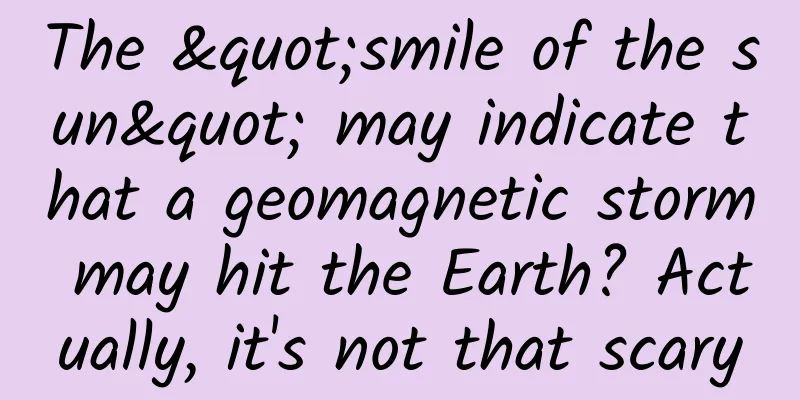The "smile of the sun" may indicate that a geomagnetic storm may hit the Earth? Actually, it's not that scary

|
Produced by: Science Popularization China Author: Wang Zheng Producer: China Science Expo Recently, a picture and related news reports have appeared in the public eye many times - the sun's "smile". On October 26, NASA released this photo with the caption: "Today, NASA's Solar Dynamics Observatory captured the sun's 'smile'. In ultraviolet imaging, these dark spots on the sun are called coronal holes, which are areas where high-speed solar wind rushes into space." Twitter @NASASun posted a photo and text of the sun's "smile" (Image source: Twitter screenshot) After the photo was released, some netizens exclaimed "cute" and used their imagination to add various elements such as hats and smiling faces to the original "smile" picture of the sun; some netizens also expressed concerns about "beware of solar storms." I believe everyone has seen a lot of related reports, but it seems that nothing has changed around us. Although the media has done a lot of publicity and emphasized the harm of this phenomenon to the earth, after listening to the terminology, it seems that nothing is understood. Today, let's take a look at what the sun's "smile" is, and is it really that scary? News media report: Beware of the "smile of the sun" Judging from the picture, the black stripes on the sun do look like the eyes and mouth of a smiling face. This real photo was captured by NASA's Solar Dynamics Observatory (SDO) satellite. The National Public Radio (NPR), the Guardian, the American Fun Science website and other media reported on it with the theme of "The smiling sun may cause problems for the earth." On October 29, the American website Popular Science published a report titled "The 'Smiling' Sun May Hit Earth with a Geomagnetic Storm This Weekend". The report pointed out that some people say that when you smile, the whole world smiles with you. But when the sun smiles, the whole world will be bathed in a shower of plasma. This is the regrettable subtext when the star closest to us shows us its lovely "smile". Screenshot of The Guardian's report on the incident (Source: Guardian website) These reports basically cite the statement that "when the sun 'smiles', the solar wind plasma will tilt down towards the earth." At the same time, according to relevant reports, scientists predict that this "charged particle wind" will hit the earth's magnetic field sometime on October 29 or 30, which may trigger a small geomagnetic storm, which may disrupt the operation of satellites in orbit and bring small-scale power grid fluctuations to the earth. How is a smile formed? The light used by satellites to capture the sun's "smile" is not the light we see with our naked eyes, but ultraviolet light, which is light with a shorter wavelength than violet light. As a large ball whose main component is hydrogen, the sun constantly undergoes high-intensity nuclear reactions inside. When the energy is transmitted to the outer layer, the hydrogen atoms in the outermost layer are at a temperature of more than 1 million degrees, thus becoming a "plasma" mixed with hydrogen ions (protons) and electrons, and constantly releasing radiation of various wavelengths - ultraviolet rays are one of them. Therefore, when taking pictures of the sun using ultraviolet rays, it is possible to get a picture of the sun "smiling". Since the photo was taken with ultraviolet light, the areas with strong ultraviolet light will be brighter, while the areas with weak ultraviolet light will be darker. The eyes and mouth of the "smile" are three huge dark areas on the corona, each of which is dozens of times larger than the Earth and is called "coronal holes." Normally, the temperature and density of the material in a coronal hole are much lower than those in the surrounding area, and the solar magnetic field is open outward, which allows the high-temperature plasma of the sun to be ejected outward at high speed along the magnetic field lines. When it enters the space around the sun, it forms a high-speed solar wind. The "plasma pouring down" and "charged particle wind" reported by the media refer to these materials. As you can imagine, high-speed solar winds are more powerful than ordinary ones. Common high-speed solar winds can reach 1,000 kilometers per second around the Earth (interestingly, the solar wind gets faster as it flies, and it is not so fast when it just leaves the Sun). It takes about 2-3 days to "blow" from the Sun to the Earth. After color processing of the image, we can see the strong outward eruption of the sun (Image source: People's Daily Online) Why is it said that the sun’s “smile” can cause magnetic storms on Earth? Since we can see that the sun is "smiling" at the earth, it is conceivable that the high-speed solar wind from the coronal hole will also erupt towards the earth. These charged particle flows can cause harm to living things and damage the circuits of electronic equipment such as satellites, but fortunately, the earth is protected by a magnetic field. On the side facing the sun, within a range of about tens of thousands of kilometers, the earth's magnetic field surrounds the earth from south to north like a cage. Charged particles cannot directly penetrate this "cage", and the magnetic field will exert a deflection force to make them detour. However, the solar wind also carries the sun's magnetic field. Under certain conditions, the interaction between the sun and the earth's magnetic fields will send the sun's charged particles and energy into the space around the earth, thereby changing the electric current surrounding the earth in space. The changing electric current also causes changes in the magnetic field, ultimately causing disturbances in the magnetic field of the entire earth. Scientists call this phenomenon a "geomagnetic storm," or magnetic storm for short. The impact of the sun's "smile" on the earth reported in the media refers to the magnetic storm. Is the sun’s “smile” this time really that scary? What are the hazards of magnetic storms? The electromagnetic activities related to magnetic storms may damage satellites and other spacecraft, interfering with the normal flight of spacecraft; at the same time, they may also generate noise to cover up normal signals during communication, or even interrupt communication; in serious cases, magnetic storms may cause large currents in the ground power transmission network, causing fluctuations in the power grid current, or even destroying the power transmission network. In order to measure the intensity of magnetic storms, scientists observed the changes in the global magnetic field and calculated a parameter called the Dst index, which is measured in nanoteslas (nT). This index varies around 0. The more negative the value, the stronger the magnetic storm. For example, the Dst index of a weak magnetic storm is about -30 to -50nT; the Dst index of a moderate magnetic storm is about -50nT to -100nT; the Dst index of a strong magnetic storm is about -100nT to -200nT; and the Dst index of a super strong magnetic storm is less than -250nT. Based on the above, let's sort out the causes and consequences of the media reports - the "smile" of the sun photographed on October 26th shows that the coronal hole is facing the earth, and the high-speed solar wind released will reach the earth in about two to three days. According to estimates, it will start to affect the earth around October 29th to October 30th, and there will be a weak magnetic storm of about Dst=-30~-50nT in these few days. Let's look at the changes in the Dst index in the figure below. The Dst index has dropped, but not much, with the lowest being -53nT. A magnetic storm of -50nT is very weak and occurs many times a year, so it is difficult for us to feel a significant change in our daily lives. DST index for October 2022 released by the International Geomagnetic Center (Image source: https://wdc.kugi.kyoto-u.ac.jp/dst_realtime/202210/index.html) Why is the sun's "smile" so spectacular, but the magnetic storm it causes is not very strong? First, similar coronal hole phenomena occur frequently, and the "smile" pattern is quite eye-catching, but it is only an occasional occurrence for the sun. Second, the "smile" facing the earth requires 2-3 days for the ejected material to reach the earth, but during this time the earth has already flown around the sun for a distance and is unlikely to be directly impacted. Therefore, the sun's "smile" that could harm the earth is not particularly scary just for this one time. Conclusion Scientists need to make precise and rigorous calculations to find out whether the particle stream ejected from the sun will hit the "small" Earth in the vast universe. If there is a major risk, scientists will issue an alert to the world, so there is no need to worry too much. Editor: Ying Yike |
>>: From collecting stamps and cards to collecting art... Why do we like collecting things so much?
Recommend
What challenges do astronauts need to overcome to return to Earth?
Chinese astronauts Tang Hongbo, Tang Shengjie and...
“Distant” and “near” marketing: What do you want consumers to pay attention to in your product?
For consumers, the author of this article propose...
iPhone battery drain culprit identified! Apple: I admit my mistake
Although the iPhone is not that popular now, and ...
Advertising results are always poor? Have you done these 5 things?
When you first came into contact with the Interne...
Will brain-like artificial intelligence become the "new favorite" of the next generation of AI?
How do high-tech robots reflect the "high&qu...
Projects that use information asymmetry to make money in 2021: group fission + freight to be paid
Information asymmetry will always exist, and peop...
Fist-sized hailstorm hits Guangzhou, smashing through car windows and roofs! How could the hail be so big?
From the afternoon to the evening of April 27, ma...
Amazing technology that is expected to move from science fiction movies to reality
We may have never been so close to the future. Yo...
Detailed explanation of Tik Tok information flow delivery strategy!
Nowadays, more and more companies and projects ar...
2020 Marketing Trend Prediction
It seems that every year, articles reviewing mark...
2022 618 Marketing Insights Report
As the most important marketing node in the year,...
Zhihu, Toutiao, NetEase Cloud Music, 21 marketing details that still have dividends
As WeChat and Weibo operations become increasingl...
Good products do not mean good sales. Sony TV has been losing money for ten years.
Whenever Sony is mentioned, its fans always assoc...
Chasing the sun and benefiting the motherland! He made solar cells an excellent example of Chinese manufacturing
When non-renewable energy sources such as natural...
There are maggots growing in my garbage dump, and you tell me it's a good thing?
Full text insect terror warning! On a rainy morni...









![[Creative Cultivation Program] Go crazy with sunflower seeds snacks, but don’t forget to pay attention to this thing in the packaging bag](/upload/images/67f262645c1ff.webp)